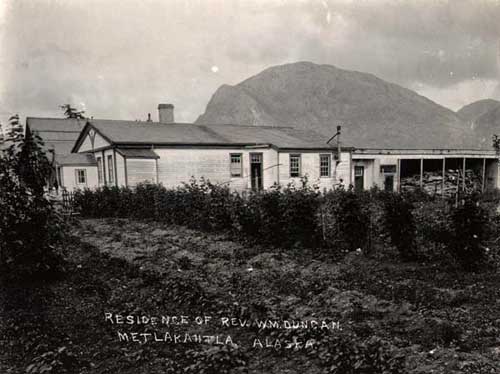
A small crowd gathered outside a two-steepled white church. It’s early in the day, but the sun is already beating down, glinting off of the lone headstone that stands beside the church. There lies Christian missionary William Duncan, a controversial and key figure in the story of this Southeast community’s history.
“No matter what anyone may think of him, William Duncan did what he thought was best for us,” Metlakatla resident David Robert Boxley said.
Boxley explained to the crowd the origins of the town’s founder.
Mr. Duncan, as he is known, strove to convert the Tsimshian community to Christianity. In 1887 Duncan arrived at Annette Island with about 800 Tsimshians from British Columbia and founded what is now Metlakatla Indian Community, about 15 miles south of Ketchikan. That arrival is marked on August 7 and celebrated as Founder’s Day.
During the wreath-laying ceremony at Duncan’s grave, Boxley reads remarks off his cell phone, alternating between English and s’malgyax, Metlakatla’s indigenous language.
“He loved us,” Boxley read. “And he worked hard to show us a good way to live.”
Boxley asked for a moment of reflection and prayer. Those in attendance bowed their heads as a wreath was laid next to the headstone. Boxley is a renowned artist and co-chair of the Haayk Foundation, a non-profit aimed at preserving the s’malgyax language. The foundation is hosting and co-sponsoring the Founder’s Day feast later this evening.
“Have a wonderful Founder’s Day, and we’re gonna get back to work,” Boxley said. “Thank you.”
The day is filled with religious significance. In this small town, the line between the duties of elected officials and dedication to the Christian faith is blurred. About 50 people convene at the Metlakatla longhouse for a community church service.
“It’s very important that our children understand the word of the Lord and they grow to know that this is the norm and this is how it should be,” Mayor Audrey Hudson said.
There are many schools of thought on how the role of missionaries like Duncan affected Native Alaskan culture. Despite the historical suppression of many Tsimshian customs, the last 30 years has seen an increase in Tsimshian cultural pride.
The interior of the longhouse is itself evidence of the ongoing cultural revival in Metlakatla. The floor and ceiling are all made of gleaming cedar. Artwork and handmade artifacts line the walls.
Founder’s Day is about more than the town’s beginning, though. It serves as a homecoming of sorts for those who were raised in Metlakatla.
David A. Boxley is David Robert’s father.
“My son did a good job,” Boxley Sr. said.
The senior Boxley was raised in Metlakatla. He lives in Seattle now, but comes back every year for Founder’s Day.
The father-and-son team have carved many totem poles together and the elder Boxley’s carving work is on display at institutes and museums all over the country. He gestures to a pole just down the street.
“My son and I did that totem pole right there for all the women who started the children’s dance groups years ago,” the senior Boxley said.
Boxley Sr. talked excitedly about the schedule of events for the day, including a parade, foot races and dance performances.
“It’s like 4th of July anywhere else, you know.”
There are even fireworks.
Standing beside William Duncan’s grave, Boxley thinks the missionary changed the Tsimshian community for the better.
“It’s really important. You know, our culture, our tribe,” Boxley said. “When this man came among our people, [he] changed our future. Absolutely changed our future. And his history, since he was 30 years old, is our history.”
Hundreds of Metlakatlans head toward town. Around the street corner and into the ballfield comes the parade procession. A little girl dressed as Disney princess Moana sits on top of a papier-mâché canoe. Representatives from the Tsimshian tribes follow, dressed in traditional regalia and beating taught, tan drums.
Kimberly Wellington is part of the Wellington Clan. She said they are descended from Arthur Wellington Clah, the man who taught William Duncan to speak s’malgyax.
Wellington and her two sons are wearing matching purple shirts with her family’s crest and s’malgyax words emblazoned on the front.
“The saying on the top means ‘love one another,’ which was my grandmother’s favorite saying, and so this is in honor of her,” Wellington said.
Many, many people milling around the ballfield are wearing these matching shirts. Wellington said making T-shirts has become a Founder’s Day tradition for the Wellington clan.
“Every year we do some sort of design with some sort of remembrance — for somebody within the family,” Wellington said.
On the 130th anniversary of Metlakatla’s founding, it’s clear that Tsimshian residents are intent on keeping traditions alive – even newer ones that call for matching T-shirts.



